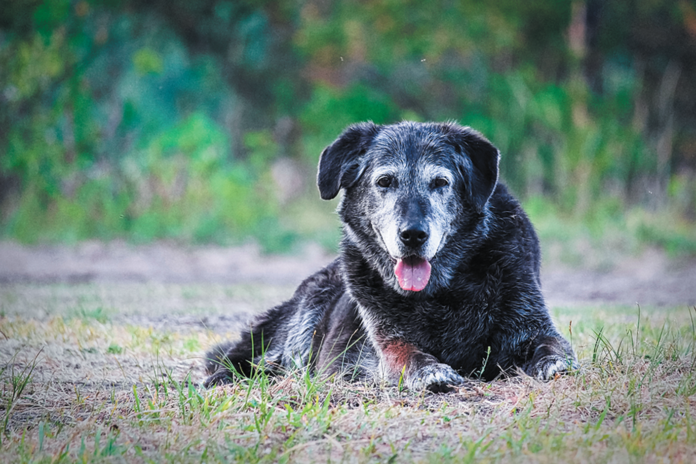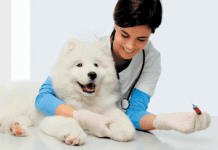One of the most common diseases to strike a large dog who reaches the age of 10 or 12 makes it difficult to breathe. This is particularly during warm weather or physical activity but even at rest when the problem progresses far enough. The ailment is called laryngeal paralysis.
The panting and struggling for breath can become almost constant, and many people mistakenly chalk it up to old age. However, feeling like you’re drowning because you can’t get enough oxygen is not a normal part of aging. An old dog such as a Lab or golden retriever or any other breed should be able to breathe comfortably. The good news: there’s a surgical fix for the condition that gives a dog back his breathing ability.
Diagnosing laryngeal paralysis
As the term “laryngeal paralysis” suggests, it means the larynx — or voice box — becomes more and more paralyzed over time. It happens because the nerves in that organ stop working. That’s a problem because the larynx doesn’t just house a dog’s vocal cords. As a long, cylinder-shaped organ made of cartilage that lies between the mouth and the windpipe (trachea), it opens widely when a dog inhales so that air can reach the lungs. If it becomes gradually paralyzed, it can’t perform that function.
Of course, there are a number of conditions that can make it difficult for a dog to breathe, especially an old dog. For a definitive diagnosis, a veterinarian needs to put a dog under sedation and reach the back of his mouth with a laryngoscope, which is a tubular instrument with a light attached. If the larynx does not open like it should, it will be readily apparent.
The diagnosis often occurs when someone brings in their dog with pneumonia. Just as the larynx is supposed to open completely to let in air, it’s supposed to close completely during swallowing. Because it can’t, food or saliva can get into the lungs during swallowing, and a type of pneumonia called aspiration pneumonia sets in.
Surgical solution
The most commonly performed surgical procedure to deal with laryngeal paralysis is called a laryngeal tie-back. The veterinary surgeon literally ties back one side of the front of the larynx with a couple of sutures so that it remains permanently open. The other side remains closed. This doesn’t fix the paralysis, but it provides a mechanical alternative that improves breathing by letting in more air while still offering significant protection against food going down “the wrong pipe.” There does remain a 25 percent risk of aspiration pneumonia throughout the dog’s life. But weighed against not being able to breathe, it’s a worthwhile tradeoff. Besides, most cases of aspiration pneumonia can be successfully treated with antibiotics.
Bottom line: If your old dog’s breathing gradually gets worse and worse, don’t assume it’s okay, and don’t assume nothing can be done. Laryngeal paralysis is one all-too-common disease that your dog doesn’t have to suffer through until he stops being able to breathe altogether. Once he has the operation, his newfound ability to breathe normally and his increased vigor will make him seem younger than he has for a long time.
The nerve damage that occurs with laryngeal paralysis is actually part of a larger condition that affects the entire body. Called Geriatric Onset Laryngeal Paralysis Polyneuropathy, or GOLPP, it affects the peripheral nerves (as opposed to the nerves in the brain and spinal cord). So if your dog has it, you might also notice weakness in the hind legs.
But it’s the labored breathing most people notice first. It’s not known if the larynx is affected first or is simply recognized first as a problem area since breathing properly is so critical. Either way, if you tend to the breathing, a dog has a very good chance of being able to live out his days without other quality-of-life issues resulting from the condition.
Note: Some veterinarians prescribe a drug called doxepin for laryngeal paralysis. It’s an anti-anxiety medication that might be able to help a dog who goes into panic mode because he’s having so much trouble breathing. The panic can make the larynx shut completely even if it is only partially paralyzed, and that worsens the breathing problem. It’s believed that in keeping a dog calm, doxepin can help ward off a cycle of panic-induced breathing crises until an operation takes place to assist breathing on a permanent basis.






My dog has difficulty breathing through his nose. Is there help?
Our small dog does too. The vet is not very interested but our dog struggles to inspire when she is at rest. Her sides suck in quite a bit. It is not normal. She is older just not quite a senior dog yet. She is a Chaweenie.
I enjoyed this article and learned things I needed to know. My 12 year old Lab is beginning to show these symptoms. Now that I know what’s going on, I can get him the help he needs early in the disability process. Many thanks.
My 13 1/2 year old golden lab mixes problem started like allergies. Lots of nasal discharge and reverse sneeze. Her cough (hack) has gotten worse over time. Now she pants all the time. I wonder if this is what’s going on or something much worse? No one can really tell me but she appears close to the end. If this was the problem I would consider having fixed. Does anyone know if nasal mucus discharge comes along with this?